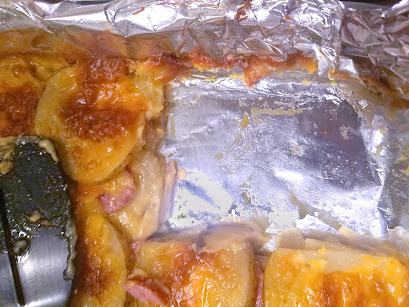Yes, in a moment of extravagance, we all got in the car and made a pilgrimage to the nearest establishment that would sell us fried chicken without making us exit the vehicle. Around here, you get gravy with your fried chicken whether you wanted it or not. No one in this house likes gravy. In the past, we have discarded the gravy like so many unwanted sauce packets, but groceries are expensive nowadays. But what does one do with a pint of gravy when no one likes gravy? We add cheese, of course! One of the greatest things about American cooking is how good we are at putting cheese in absolutely everything.
|
Cheesy Spuds 3 or 4 large russet potatoes 2 c white gravy 8 oz grated or sliced cheese (whatever kind you like) 1 egg, optional ½ - 1 lb kielbasa, or any other fully-cooked sausage, sliced (if desired) Heat oven to 350°. Line a 9x13 pan with foil, then grease it. Be sure to scrub the potatoes well unless you want to peel them (but this is very good and faster to make with the potato skins left on). Slice the potatoes about a quarter inch thick or so. If the sausage is fairly big across, first cut it in half (or quarters) lengthwise so that when you slice it, the slices are bite-size. Set aside about a quarter cup of the cheese. Heat the gravy over low heat until it just boils. Turn off the heat and immediately stir in the cheese. The heat should melt the cheese without curdling it, but turn on the stove for just a little bit if not. Stir in the egg, if using (it makes the cheese sauce creamier and drastically reduces any oil separation from the cheese). Put a layer of potatoes and sausage in the pan, then pour a little of the cheese sauce on top. Repeat these layers, using a more generous amount of cheese sauce per layer as you get toward the top. Be sure to use only potatoes on the topmost layer as the sausage would over-crisp. Pour the last of the cheese sauce on top. Sprinkle the reserved cheese on everything, and bake until the potatoes are done. |
You can make your own white sauce, but if you happened to get fried chicken at a drive-thru, the probably sent you home with a pint of it. So you can skip this business of beating out flour lumps, and get right to the part where you add a lot of cheese.
It doesn't really matter how much cheese you put in here. Measure with your heart. In this case, we're using the rest of a block of cheese that has been refrigerating for long enough that it was nearing expiration.
 |
| We stopped shredding and figured what remained was thin enough to melt. |
Whether you're making cheese sauce or just sprinkling shredded cheese between each layer, be more parsimonious with the cheese in the bottom layers and more liberal with it as you get to the top layers. It tends to sink down as it bakes. As you can see, we've sort of barely sprinkled it on this first layer, but really gobbed it on the top.
Potatoes take a long time to bake, so by the time they are done, the cheese on top has become a marvelous layer of crispiness that spans the pan from edge to edge.









Holy crap, the places near you give entire TUBS of gravy? That... is an excessive amount of gravy.
ReplyDeleteGood gr--er... well... you know.
Good gravy or good grief both work.
DeleteAnd... yes they do. I never know what to do with it all.
I love the challenge of figuring out good things to do with unwanted/ soon-to-expire foods. I call it the "Chopped" home game.
ReplyDeleteMe too! A lot of times they end up being a lot better than what I'd make from nothing because there's no "Don't use too much ____ because we have to save it!"
Delete